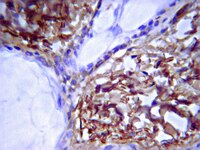Interleukin-6 production in CD40-engaged fibrocytes in thyroid-associated ophthalmopathy: involvement of Akt and NF-κB.
Gillespie, EF; Raychaudhuri, N; Papageorgiou, KI; Atkins, SJ; Lu, Y; Charara, LK; Mester, T; Smith, TJ; Douglas, RS
Investigative ophthalmology & visual science
53
7746-53
2011
Kivonat megmutatása
CD40-CD40 ligand (CD40L) interactions appear to play pathogenic roles in autoimmune disease. Here we quantify CD40 expression on fibrocytes, circulating, and bone marrow-derived progenitor cells. The functional consequences of CD40 ligation are determined since these may promote tissue remodeling linked with thyroid-associated ophthalmopathy (TAO).CD40 levels on cultivated fibrocytes and orbital fibroblasts (GOFB) from patients with Graves' disease (GD), as well as fibrocyte abundance, were determined by flow cytometry. CD40 mRNA expression was evaluated by real-time PCR, whereas response to CD40 ligation was measured by Luminex and RT-PCR. Protein kinase B (Akt) and nuclear factor (NF)-kappa B (NF-κB) signaling were determined by Western blot and immunofluorescence.Basal CD40 expression on fibrocytes is greater than that on GOFB. IFN-γ upregulates CD40 in both cell types and its actions are mediated at the pretranslational level. Fibrocytes produce high levels of cytokines, including interleukin-6 (IL-6), TNF-α, IL-8, MCP-1, and RANTES (Regulated on Activation, Normal T Cell Expressed and Secreted) in response to CD40L. IL-6 induction results from an increase in steady state IL-6 mRNA, and is mediated through Akt and NF-κB activation. Circulating CD40(+)CD45(+)Col1(+) fibrocytes are far more frequent in vivo in donors with TAO compared with healthy subjects.Particularly high levels of functional CD40 are displayed by fibrocytes. CD40L-provoked signaling results in the production of several cytokines. Among these, IL-6 expression is mediated through Akt and NF-κB pathways. The frequency of circulating CD40(+) fibrocytes is markedly increased in patients with TAO, suggesting that this receptor might represent a therapeutic target for TAO. | 23092922
 |
Increased expression of TSH receptor by fibrocytes in thyroid-associated ophthalmopathy leads to chemokine production.
Erin F Gillespie,Konstantinos I Papageorgiou,Roshini Fernando,Nupur Raychaudhuri,Kimberly P Cockerham,Laya K Charara,Allan C P Goncalves,Shuang-Xia Zhao,Anna Ginter,Ying Lu,Terry J Smith,Raymond S Douglas
The Journal of clinical endocrinology and metabolism
97
2011
Kivonat megmutatása
The molecular basis for anatomically dispersed clinical manifestations in Graves' disease (GD) eludes our understanding. Bone marrow-derived, pluripotent fibrocytes represent a subset of peripheral blood mononuclear cells and infiltrate the orbital and thyroid tissues in GD. These cells may be involved in the pathogenesis of thyroid-associated ophthalmopathy (TAO). | 22399514
 |
Beneficial Regulation of Fibrillar Collagens, Heat Shock Protein-47, Elastin Fiber Components, Transforming Growth Factor-β1, Vascular Endothelial Growth Factor and Oxidative Stress Effects by Copper in Dermal Fibroblasts.
Neena Philips,Philips Samuel,Harit Parakandi,Sesha Gopal,Halyna Siomyk,Abraham Ministro,Terrel Thompson,Gadi Borkow
Connective tissue research
53
2011
Kivonat megmutatása
Skin aging is associated with the loss of the structural collagens and the elastin fiber components that form the extracellular matrix (ECM). It is associated with reduced transforming growth factor-β (TGF-β), angiogenesis and increased oxidative stress. Copper has been incorporated into cosmetics for anti-skin aging. This research investigated the mechanism for the anti-skin aging effect copper ions, from cuprous oxide powders. Dermal fibroblasts were exposed to copper and examined for expression (protein and/or promoter levels) of types I, III, V collagen, heat shock protein-47 (HSP-47), elastin, fibrillin-1, and fibrillin-2, TGF-β1, vascular endothelial growth factor (VEGF), and in addition for membrane damage and lipid peroxidation. The direct antioxidant activity of copper was also determined. The research indicates that copper's anti-skin aging and skin regeneration potential is through its stimulation of ECM proteins, TGF-β1, VEGF, and inhibition of oxidative stress effects at physiological concentrations; and supports its use in cosmetics. Dr. Gadi Borkow is the chief medical scientist of Cupron Scientific. | 22324999
 |











